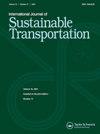CanBikeCO全面试点:美国科罗拉多州电动自行车项目的长期结果和分析
IF 3.9
3区 工程技术
Q2 ENVIRONMENTAL STUDIES
International Journal of Sustainable Transportation
Pub Date : 2025-07-01
DOI:10.1080/15568318.2025.2475149
引用次数: 0
摘要
个人微型交通工具,如自行车、电动自行车和踏板车,是单人车辆的低能耗或零能耗替代品。然而,数据的缺乏导致了对个人拥有的电动自行车使用情况的数据驱动研究的缺乏。我们展示了CanBikeCO项目的纵向调查结果,重点关注了科罗拉多州的人口统计、出行特征和地理位置对电动自行车的采用和使用。从2021年7月到2022年12月,CanBikeCO记录了科罗拉多州能源办公室在科罗拉多州六个社区提供的个人电动自行车的低收入个人的旅行调查数据。数据是使用国家可再生能源实验室OpenPATH平台的自定义实例收集的,该平台将被动数据收集与行程模式和目的标签等语义信息相结合。据我们所知,在此之前还没有针对个人拥有的电动自行车的出行调查数据。从这个独特的数据集得出的见解包括:(i)工作旅行比骑电动自行车的平均旅行多17%;(ii)据报道,电动自行车最常取代汽车(34%的电动自行车旅行)和其他个人微移动设备(22%);(iii)参与者喜欢在1英里以内的旅行中步行,在1 - 3英里的旅行中骑电动自行车,在3-20英里的旅行中骑电动自行车、汽车或共享交通工具。用于生成这些结果的数据已在运输安全数据中心提供。我们发现电动自行车的使用在各个年龄段都具有吸引力,并且可能与土地使用、城市形态、职业、收入和汽车所有权的特征有关。对于这一人群,我们得出的结论是,使用电动自行车所增加的能源需求(诱导需求和取代非机动模式)被用电动自行车取代单人车辆出行所减少的能源需求所抵消。我们的研究结果表明,拥有个人电动自行车可以节省大量能源。本文章由计算机程序翻译,如有差异,请以英文原文为准。
The CanBikeCO full pilot: Long-term results and analysis from an E-bike program in Colorado, USA
Personal micromobility devices like bicycles, e-bikes, and scooters are low- or zero-energy alternatives to single-occupancy vehicles. However, a lack of data has led to a dearth of data-driven research on personally owned e-bike usage. We present longitudinal findings from the CanBikeCO program, focused on e-bike adoption and use across demographics, trip characteristics, and geographies in the state of Colorado. CanBikeCO recorded travel survey data from low-income individuals provided with personal e-bikes by the Colorado Energy Office in six communities across Colorado from July 2021 to December 2022. The data were collected using a custom instance of the National Renewable Energy Laboratory OpenPATH platform, which combines passive data collection with semantic information such as trip mode and purpose labels. To our knowledge, there are no prior travel survey data on personally owned e-bikes with this range and scope. Insights from this unique dataset include: (i) work trips were 17% more likely than average trips to be taken on an e-bike, (ii) e-bikes were most often reported to replace cars (34% of e-bike trips) and other personal micromobility devices (22%), and (iii) participants favored walking for trips less than 1 mile, e-bikes for trips of 1–3 miles, and e-bikes, cars, or shared rides for trips of 3–20 miles. The data used to generate these results have been made available in the Transportation Secure Data Center. We find e-bike use is appealing across age groups and may be related to characteristics of land use, urban form, occupation, income, and car ownership. We conclude for this population that the energy demand added by e-bike use (induced demand and replacing non-motorized modes) is outweighed by the reduction in energy demand from replacement of single-occupancy vehicle trips with e-bike trips. Our findings suggest considerable potential for energy savings from personal e-bike ownership.
求助全文
通过发布文献求助,成功后即可免费获取论文全文。
去求助
来源期刊
CiteScore
8.90
自引率
2.60%
发文量
56
期刊介绍:
The International Journal of Sustainable Transportation provides a discussion forum for the exchange of new and innovative ideas on sustainable transportation research in the context of environmental, economical, social, and engineering aspects, as well as current and future interactions of transportation systems and other urban subsystems. The scope includes the examination of overall sustainability of any transportation system, including its infrastructure, vehicle, operation, and maintenance; the integration of social science disciplines, engineering, and information technology with transportation; the understanding of the comparative aspects of different transportation systems from a global perspective; qualitative and quantitative transportation studies; and case studies, surveys, and expository papers in an international or local context. Equal emphasis is placed on the problems of sustainable transportation that are associated with passenger and freight transportation modes in both industrialized and non-industrialized areas. All submitted manuscripts are subject to initial evaluation by the Editors and, if found suitable for further consideration, to peer review by independent, anonymous expert reviewers. All peer review is single-blind. Submissions are made online via ScholarOne Manuscripts.

 求助内容:
求助内容: 应助结果提醒方式:
应助结果提醒方式:


